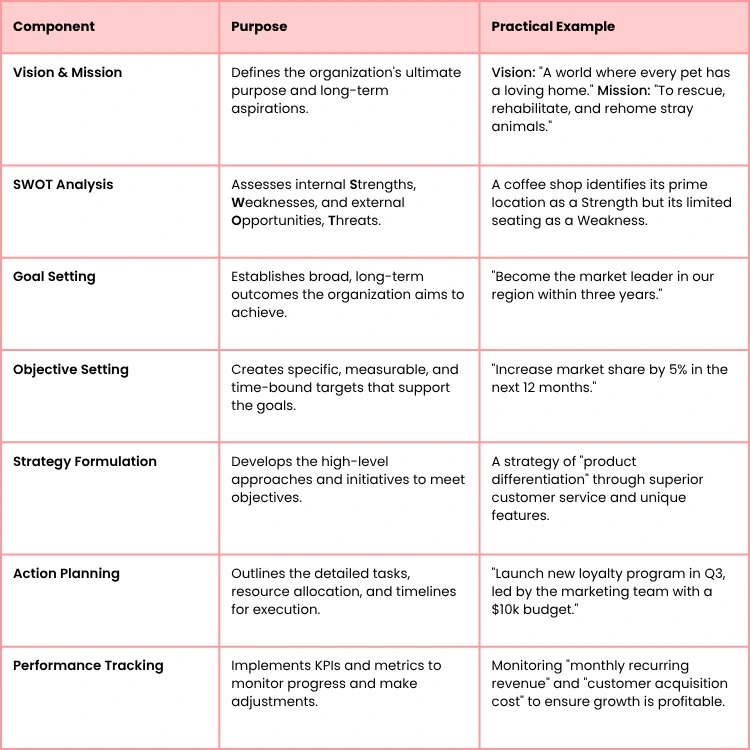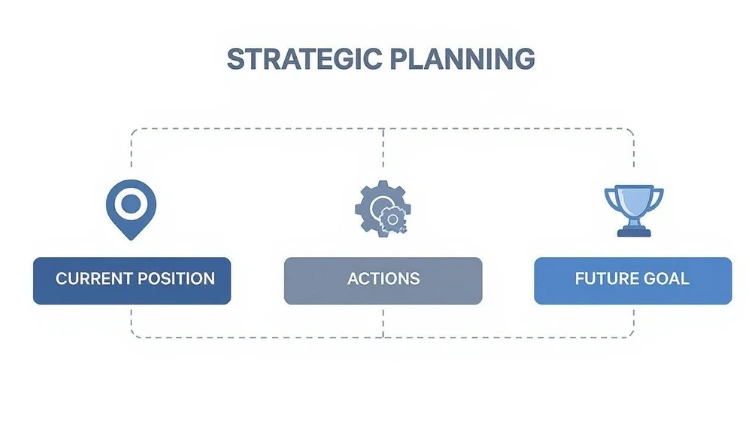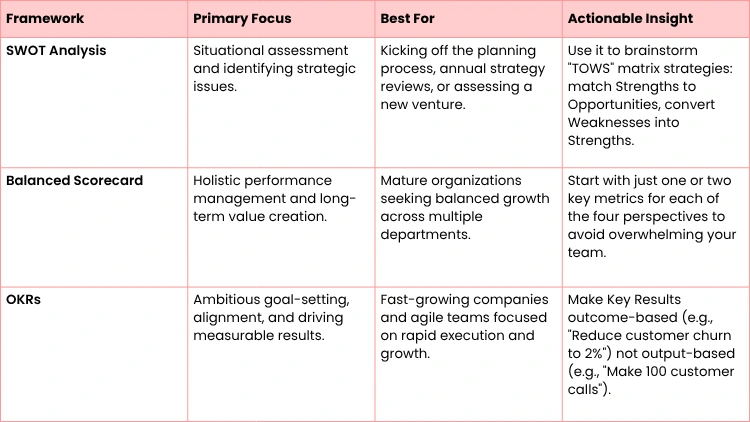What is Strategic Planning Process: A Practical Guide

The strategic planning process is your company's formal way of drawing a map to its future. It's about defining a clear vision, setting tangible goals, and then outlining the practical steps needed to get there. Done right, it ensures everyone is rowing in the same direction.
Jump To Section

Earn As You Learn
Earn 25% commission when your network purchase Uplyrn courses or subscribe to our annual membership. It’s the best thing ever. Next to learning,
of course.
What Is The Strategic Planning Process Really About
Picture this: you decide to go on a big cross-country road trip. But you don’t have a map, a GPS, or even a final destination in mind. You might stumble upon some cool spots by accident, but you’ll probably waste a ton of gas, get hopelessly lost, and never really feel like you’ve arrived anywhere meaningful.
That's what running a business without a strategic plan is like. The process is your organization’s navigation system. It’s a detailed map showing exactly where you are today, where you want to be in the future, and the best routes to take to get there.
Forget the idea of a stuffy corporate document that gets filed away and forgotten. A good strategic plan is a living, breathing framework that helps you make smarter, more informed decisions every single day. It forces leaders to pull their heads out of the daily grind and look at the bigger picture. It’s about asking the tough questions: What are we really trying to achieve? What’s coming around the corner in our market? Where should we focus our limited time, money, and talent to make the biggest splash?
The Core Purpose of a Strategic Plan
At its heart, strategic planning is about being intentional. Instead of constantly reacting to market shifts or putting out internal fires, a solid plan helps you get ahead of them. This proactive approach gives you a massive competitive edge.
- Practical Example: Think of a small e-commerce business selling handmade jewelry. Through strategic planning, they might spot a growing consumer trend toward sustainable products. They could then build objectives around sourcing recycled metals and using eco-friendly packaging. By marketing this difference, they’re not just selling accessories—they're building a brand with a purpose that attracts a specific, loyal customer base.
The numbers don't lie. Research from Funding for Good found that simply having a written strategic plan can double an organization's odds of success. It's a huge indicator of preparedness. In fact, 71% of fast-growing companies have formal strategic plans, while nearly half of all nonprofits don't have one at all.
Strategic planning closes the gap between your current reality and your future aspirations. It transforms a vague vision into a concrete set of actions, providing clarity and a unified direction for the entire team.
Of course, a plan is only as good as its execution. This is where many organizations fall flat, which is why it's crucial to understand why planning does not work and what to do about it. A well-designed process tackles this head-on by building buy-in and a sense of ownership from the very beginning.
To help break it down, here are the fundamental pieces that make up any effective strategic plan.
Core Components Of The Strategic Planning Process
This table summarizes the essential building blocks of the process, from high-level vision to on-the-ground execution.
Each of these components plays a critical role in creating a cohesive and actionable roadmap for your organization's success.

The Six Phases Of Effective Strategic Planning
Jumping into strategic planning can feel like you're gearing up for a massive expedition. You know the destination is worth it, but the path looks incredibly complex. The trick is to break it down. By splitting the journey into distinct, manageable phases, you can turn an overwhelming task into a clear, step-by-step roadmap that actually works.
Think of the whole process as moving from where you stand today, through a series of carefully planned actions, to arrive at your desired future.
Let's walk through the six critical phases that make this journey a success.
Phase 1: Preparing For The Journey
Before you even whisper the word "goals", you have to get ready for the process itself. This initial phase is all about building a solid foundation by getting your leadership team on the same page and setting clear expectations for what's to come. It’s like gathering your expedition crew to agree on the destination and the rules of the trail before anyone takes a single step.
The main objective here is to get consensus. Do all your senior leaders agree that a strategic plan is necessary? Are they truly committed to dedicating the time and resources it will demand? According to The Strategy Institute, this stage often involves workshops to create a shared vision among executives, employees, and partners. The goal is to align everyone around the organization's core purpose. You can learn more by checking out their insights on the key phases of strategic planning.
- Actionable Insight: Schedule a kickoff meeting with every key stakeholder. The only purpose of this meeting should be to agree on the process, not the strategy. Define the timeline, figure out who needs to be involved, and decide what a successful outcome looks like. For example, agree that "a successful plan will be a one-page document that every employee can understand."
Phase 2: Analyzing Your Surroundings
With everyone on board, it's time for a brutally honest look at where you are right now. This situational analysis is all about understanding both your internal world (your strengths and weaknesses) and the external landscape (your opportunities and threats). This is exactly where frameworks like SWOT analysis become indispensable.
Picture it as a scout surveying the terrain. What resources do you have at your disposal (a skilled team, a strong brand)? What are your limitations (outdated tech, tight budget)? What outside factors could give you a boost (an emerging market trend)? And what could trip you up (a new competitor, changing regulations)?
- Actionable Insight: Don't just rely on the leadership team's perspective. Send out a simple, anonymous survey to employees asking for their take on the company's strengths and weaknesses. The front-line view is often more accurate and can uncover blind spots. For a deeper dive, check out this comprehensive guide on how to do a stakeholder analysis in business.
Phase 3: Formulating The Strategy
Now that you have a clear picture of reality, you can start charting the course. Strategy formulation is where you make the big, directional decisions that will define your future. This isn't about listing out daily tasks; it's about defining your competitive edge and setting high-level, long-term goals.
This phase answers the big questions:
- Where will we play? Which markets, customer segments, and geographic areas will be our focus?
- How will we win? What makes us unique? Will we compete on price, quality, innovation, or service?
- What are our strategic goals? What broad, long-term outcomes are we aiming for over the next 3-5 years?
- Practical Example: A local coffee shop, after analyzing its situation, might formulate a strategy to "become the premier destination for remote workers". Its goals would then focus on beefing up the Wi-Fi, adding more power outlets, and creating a loyalty program for daytime customers—instead of trying to compete with national chains on price.
Phase 4: Creating The Action Plan
A brilliant strategy is just a nice idea without a concrete plan to bring it to life. This is where you translate your big-picture goals into specific, tangible initiatives, connecting your vision to the day-to-day work of your teams.
An action plan is the bridge between your strategic vision and operational reality. It assigns ownership, sets deadlines, and allocates the resources needed to turn goals into accomplishments.
Here, each strategic goal gets broken down into smaller objectives and key results (OKRs) or key performance indicators (KPIs). For every single objective, you must define:
- What specific actions need to be taken.
- Who is responsible for leading the charge.
- What resources (budget, staff, tools) are required.
- What the timeline for completion is.
- Actionable Insight: Use the "Who, What, When" framework for every action item. For example: Who: Marketing Lead. What: Launch new customer referral program. When: By the end of Q2. This simple structure builds immediate accountability into your plan.
Phase 5: Executing The Plan
This is where the rubber meets the road. Execution is all about weaving the strategic plan into the fabric of your organization's daily operations. It demands consistent communication, strong leadership, and empowering your teams to actually carry out their assigned tasks.
Success here is all about momentum. Leaders must relentlessly communicate the plan, celebrate early wins to keep morale high, and actively remove roadblocks for their teams. This isn’t a "set it and forget it" activity; it's an active, ongoing management process.
- Actionable Insight: Establish a regular "rhythm" for strategic conversations. This could be a monthly strategy meeting or a quarterly review. Use a visual dashboard (even a simple spreadsheet) to track progress on key initiatives. This makes progress tangible and keeps everyone focused on the finish line.
Phase 6: Measuring And Adapting
Finally, no plan survives contact with reality unscathed. The sixth phase, measurement and adaptation, is a continuous loop of tracking progress, evaluating results, and making smart adjustments along the way. The market will shift, new opportunities will pop up, and some of the assumptions you made will turn out to be wrong.
This is why setting clear KPIs back in Phase 4 is so critical. These metrics are your dashboard, telling you if you’re on track, ahead of schedule, or falling behind. Regular reviews of this data allow you to be agile. You can double down on what's working and pivot away from what isn't.
- Practical Example: A software company's plan is to increase user retention. They track "monthly churn rate". After two months, the rate isn't improving. By reviewing the data, they realize users are dropping off during the onboarding process. They adapt by reallocating resources to create a better tutorial, directly addressing the problem the data revealed.
This visual really drives home the point: strategic planning is a deliberate process. It’s all about closing the gap between your current reality and your future aspirations.

Choosing Your Strategic Planning Framework
A strategic plan without a solid framework is like a powerful engine dropped onto a bare frame—all that potential is useless without a structure to channel its energy. Strategic frameworks provide that essential architecture. They give your thinking a backbone, guiding you from big, abstract ideas to a concrete, actionable roadmap.
Think of them as a set of proven blueprints. They help you ask the right questions at the right time and force you to focus on what really matters. The key is picking the one that fits your company's culture, your current challenges, and where you want to go. Let's dig into three of the most effective and widely-used frameworks out there.
SWOT Analysis: The Foundational Snapshot
Before you can chart a course for the future, you have to know exactly where you're standing right now. That’s what a SWOT Analysis is for. It’s the foundational diagnostic tool in any strategist’s toolkit, forcing a brutally honest look at both your internal realities and the external world around you.
The framework itself is beautifully simple but incredibly powerful. It breaks down your situation into four distinct quadrants:
- Strengths (Internal): What do you do better than anyone else? This could be your killer brand reputation, a deeply talented team, or some proprietary tech that gives you an edge.
- Weaknesses (Internal): Where are the cracks in your armor? Be honest. It might be a bloated cost structure, clunky internal processes, or a critical skill gap on your team.
- Opportunities (External): What trends or shifts in the world can you capitalize on? Think emerging markets, new technologies, or changing customer behaviors.
- Threats (External): What’s out there that could sink you? This could be a disruptive new competitor, tightening government regulations, or a looming economic downturn.
Practical Example: Imagine a small, independent bookstore trying to survive against the online giants. A quick SWOT might look like this:
- Strength: A loyal, tight-knit community and a reputation for amazing, personalized book recommendations.
- Weakness: A tiny marketing budget and limited physical inventory.
- Opportunity: A growing "shop local" movement and interest in community events.
- Threat: Relentless price pressure from huge online retailers and the rise of e-books.
Just like that, a strategic path starts to emerge. The bookstore can leverage its Strength (community) to seize an Opportunity (local events), which helps neutralize the Threat (online competition). They could start hosting author readings or book clubs, cementing their role as a community hub—something an algorithm-driven website can never truly replicate.
The Balanced Scorecard: A Holistic View of Performance
If SWOT gives you a snapshot of your current position, the Balanced Scorecard (BSC) provides a comprehensive dashboard for the journey ahead. Developed by Drs. Robert Kaplan and David Norton, this framework was born from the idea that focusing only on financial metrics is like driving a car while only looking in the rearview mirror. It tells you where you've been, but it's useless for navigating what's next.
The BSC pushes for a more, well, balanced view of organizational health by tracking performance across four interconnected perspectives:
- Financial Perspective: How do we look to our shareholders? (e.g., revenue growth, profitability)
- Customer Perspective: How do customers see us? (e.g., customer satisfaction, brand loyalty)
- Internal Business Process Perspective: What must we excel at internally? (e.g., operational efficiency, product innovation)
- Learning and Growth Perspective: How can we continue to improve and create value? (e.g., employee skills, company culture, technology)
The Balanced Scorecard connects the dots between day-to-day operational activities and the organization’s high-level strategic objectives. It ensures that improvements in one area don't come at the expense of another, creating sustainable, long-term success.
Practical Example: A manufacturing company uses BSC. They want to improve profitability (Financial). Instead of just cutting costs, their scorecard includes an objective to reduce production defects (Internal Process), which lowers waste and boosts profits. It also includes an initiative to upskill their machine operators (Learning & Growth), which directly improves the defect rate. This creates a chain reaction of positive results. It’s a core component of building a robust business strategy.
OKRs: Fueling Ambitious and Measurable Growth
While the Balanced Scorecard is a steady dashboard, Objectives and Key Results (OKRs) are the high-performance GPS for ambitious, fast-moving teams. Made famous by tech giants like Google and Intel, the OKR framework is engineered to drive focus, alignment, and engagement around audacious goals. It’s all about setting a crystal-clear destination and then defining the measurable milestones that prove you’re actually getting there.
The structure is brilliantly simple:
- Objectives (O): These are the big, ambitious, qualitative goals you want to achieve. They should feel inspiring and maybe a little bit daunting. An objective answers, "Where are we going?"
- Key Results (KR): These are the specific, measurable outcomes that demonstrate you've reached your objective. You'll typically have 2-5 key results for each objective. A key result answers, "How do we know we got there?"
The magic of OKRs lies in their ability to cascade from the company level all the way down to individual contributors, creating a clear line of sight for everyone. It's no surprise that 75% of high-growth companies now use OKRs to get everyone rowing in the same direction.
Practical Example: A SaaS startup aiming for rapid scale. Their Q3 OKR might be:
- Objective: Become the go-to project management tool for creative agencies.
- Key Results:
- Increase new monthly recurring revenue (MRR) by 30%.
- Achieve a Net Promoter Score (NPS) of 55 or higher.
- Onboard 10 major creative agencies as new clients.
Suddenly, there’s no ambiguity. The sales, marketing, and product teams know exactly what winning looks like. They can align their own weekly tasks and projects directly to hitting those key results.

Comparing Popular Strategic Planning Frameworks
So, which framework is right for you? There's no single "best" answer—it all depends on your organization's specific needs, maturity, and goals. The table below breaks down the core differences to help guide your decision.
Ultimately, SWOT is a fantastic starting point for almost everyone. From there, the Balanced Scorecard provides a robust system for maintaining long-term health, while OKRs offer the fuel for aggressive, short-cycle growth sprints. Many successful companies even use a hybrid approach, using SWOT to inform their annual planning and OKRs to execute it quarter by quarter.

How Strategic Planning Works In The Real World
Knowing the frameworks is one thing. Watching them work in the chaos of the real world is where the real learning begins.
Strategic planning isn't some sterile academic exercise played out on a whiteboard. It’s a messy, dynamic tool that real companies use to make tough calls, navigate uncertainty, and ultimately, get things done.
Let's move from theory to practice and look at two behind-the-scenes examples. These stories show how different businesses used specific strategic frameworks to tackle their unique problems and win.
Case Study 1: The Agile Tech Startup
Picture a fast-growing tech startup we'll call "InnovateNow". They've just closed their Series A funding, and the clock is ticking. The market is a minefield, and they have to grab market share before the big, slow-moving competitors even notice them.
A traditional five-year plan would be a joke—obsolete before the ink was dry.
So, InnovateNow went with the Objectives and Key Results (OKR) framework to stay nimble and razor-focused. Their big-picture goal was clear: achieve product-market fit in the enterprise sector within 18 months.
They broke that massive goal down into quarterly sprints:
- Q1 Objective: Validate Enterprise Demand.
- Key Results:
- Secure 10 pilot programs with Fortune 500 companies.
- Achieve a user engagement score of 8/10 from pilot users.
- Convert 3 pilot programs into paid annual contracts.
Suddenly, every team—from sales to engineering—had a clear, measurable target. At the end of Q1, they had only landed five pilot programs, which felt like a miss. But their user engagement was a perfect 10/10.
Digging into the feedback, they uncovered a game-changing insight: their tool wasn't quite right for giant enterprises, but it was a perfect fit for mid-sized companies.
Because their OKR process was built for learning, they didn't see this as a failure. It was priceless data. In Q2, they pivoted their entire strategy to chase the mid-market. The result? They crushed their annual revenue goals by 40%.
This is a perfect example of how a flexible framework lets a company learn and adapt on the fly. For young companies, getting these foundational decisions right is everything, as covered in this guide on the startup blueprint for long-term success.
Case Study 2: The Established Retailer's Revival
Now, let's look at "Heritage Goods", a 50-year-old retail chain. Foot traffic was plummeting, and e-commerce giants were eating their lunch. Their brand felt stale, and their relentless focus on sales was pushing away a whole new generation of customers.
They needed more than a quarterly sales push; they needed a total reinvention.
Heritage Goods turned to the Balanced Scorecard (BSC) to guide their transformation. They finally admitted that their obsession with financial metrics was the very thing holding them back. The BSC forced them to look at the whole picture.
A strategic plan is the mechanism that translates a company's mission into measurable success. For Heritage Goods, the Balanced Scorecard provided the structure to ensure their turnaround efforts were comprehensive and sustainable.
Here’s how they built their BSC to engineer a comeback:
- Financial Perspective: The goal was simple: increase profitability. A key objective was to grow online sales revenue by 30% within two years.
- Customer Perspective: To fix their brand image, they aimed to improve their Net Promoter Score (NPS) by 15 points, shifting the focus from one-off transactions to building real loyalty.
- Internal Process Perspective: They had to get good at e-commerce, fast. A critical objective was to reduce order fulfillment time by 50% by overhauling their warehouse management system.
- Learning & Growth Perspective: To create a culture that actually cared about customers, they set a goal: 100% of store staff had to complete a new customer experience training program.
By tracking metrics across all four areas, Heritage Goods made sure every part of their strategy worked together. The investment in staff training (Learning & Growth) directly led to better service, which boosted their NPS (Customer), which created repeat business and supported their revenue goals (Financial).
This holistic approach was the engine for modernizing their brand and building a future that was actually sustainable.
Best Practices For A Successful Strategic Plan
A brilliant strategic plan can look perfect on paper, but even the most well-designed roadmap is useless if it gets left in a drawer. The difference between a plan that inspires action and one that gathers dust really comes down to execution.
Following a few core best practices can make sure your strategic planning process translates into real-world results.
Simply put, a plan fails when it becomes disconnected from the very people who have to bring it to life. Here’s how to avoid that common pitfall and build a strategy that actually sticks.
Secure Genuine Leadership Buy-In
This goes way beyond a simple sign-off. True buy-in means leaders are actively and consistently championing the plan, not just in the boardroom but in their daily decisions and team communications.
When leadership commitment is only surface-level, the strategy quickly loses steam the moment the first obstacle appears.
- Actionable Insight: Don't just present the final plan for approval. Involve senior leaders throughout the development process. Ask them to lead brainstorming sessions for their own departments and publicly share how their team's work connects directly to the new strategic goals. Their visible ownership is contagious.
Involve Team Members At All Levels
The people on the front lines often have the sharpest insights into what’s working and what isn’t. Excluding them from the process breeds resentment and disengagement. Including them, on the other hand, fosters a powerful sense of ownership.
A plan created for people is always less effective than a plan created with them.
When your team feels like they are co-authors of the strategy, they become its most passionate advocates. This transforms execution from a top-down mandate into a shared mission.
- Practical Example: Imagine a manufacturing company aiming to improve efficiency. They could hold "innovation workshops" with floor supervisors and machine operators. Their input on workflow bottlenecks and tool improvements is far more practical than what an executive might guess, leading to more realistic and effective action plans that people are eager to implement.
Communicate The Plan Relentlessly
You really cannot over-communicate your strategic plan. A single all-hands meeting just isn't enough. The vision and priorities must be woven into the very fabric of daily work.
Consistent communication keeps the strategy top-of-mind. It helps everyone see how their individual contributions fit into the bigger picture.
- Actionable Insight: Use the "Rule of Seven". The idea is that most people need to hear a message seven times before it sinks in. Share the strategy in an all-hands meeting, an email, a team huddle, a visual poster, a newsletter, a 1-on-1 meeting, and another team huddle. It might feel repetitive to you, but it’s essential for clarity.
Link Strategy Directly To Budgets
A strategy without resources is just a wish list. The most successful plans are directly tied to the budgeting process, ensuring that money, time, and talent are allocated to the most critical initiatives.
This forces tough decisions and makes it crystal clear what the organization is—and is not—prioritizing. Embracing data-driven approaches is a critical best practice here, leading to a more informed and effective data-driven business strategy.
- Practical Example: If a key strategic goal is to "expand into the European market" but the annual budget has zero allocation for international marketing or translation services, the plan is destined to fail. The budget must mirror the strategy for it to be credible.
Finally, establish a rhythm for regular progress reviews. These checkpoints are crucial for tracking metrics, identifying roadblocks, and adapting to change. By defining clear metrics upfront, you can objectively measure success.
This approach creates a culture where the strategic plan is a living, breathing document—not a static artifact.

Building Your Blueprint For The Future
Ever watched an architect design a skyscraper? They don't just sketch out a single floor and hope for the best. They create a comprehensive blueprint that guides every single decision, from laying the foundation to the final coat of paint. That's exactly what a strategic plan is for your business: a detailed blueprint for its future.
This entire process is about turning those big, abstract visions you have into something real and achievable. By working through the essential phases—starting with an honest look at where you are and moving into disciplined execution—you create a powerful sense of clarity and get everyone on the same page. Frameworks like SWOT, a Balanced Scorecard, or OKRs provide the structure you need to keep the team focused and pulling in the same direction.
But here’s the thing about blueprints: they're only useful if you actually follow them. Real success comes from execution and treating your plan as a living, breathing document that shapes the work you do every day. As you get started on your own blueprint, a great next step is to consult an ultimate guide to creating a winning business plan to help translate your strategy into a story that resonates with stakeholders.
Strategic planning isn't a one-and-done event. It's a continuous cycle of learning, adapting, and getting better. Think of it as the engine that drives clarity, alignment, and unstoppable momentum toward your most ambitious goals.
The whole journey begins with one simple step. Put some time on the calendar today to talk with your team. Get the conversation started about your long-term vision, and then ask a simple but powerful question: "What's the single most important thing we can do this quarter to get closer to that future?"
Strategic Planning FAQs
As you start putting all this into practice, a few questions always seem to pop up. Let's tackle some of the most common ones to clear the path from theory to action.
How Often Should We Update Our Plan?
A strategic plan isn't a "set it and forget it" document you write once and file away. Think of it as a living, breathing guide for your business. While you'll probably only do a major overhaul every 3-5 years, it needs regular attention to stay useful.
The market, technology, and your customers are moving way too fast for a static plan. That’s why we recommend an annual refresh and, even more importantly, quarterly check-ins.
- Actionable Insight: Schedule these reviews in your calendar for the entire year, right now. Treat them as non-negotiable appointments. This simple act prevents them from being pushed aside by "more urgent" tasks and ensures strategic thinking becomes a consistent habit.
What Is The Difference Between Strategic And Operational Planning?
It’s easy to get these two mixed up, but the distinction is crucial.
Imagine you're building a house. Strategic planning is the architect's blueprint. It’s the high-level vision—how many stories the house will have, its overall style, and where it will sit on the property. It answers the big "what" and "why" questions.
Operational planning, on the other hand, is the contractor's daily to-do list. It's the nitty-gritty of how the work gets done: pouring the foundation on Monday, framing the walls by Friday, and scheduling the plumber for next week. It’s all about the "how" and "when". You can't have one without the other; they work together at different altitudes.
Can A Small Business Do Strategic Planning?
Absolutely. In fact, you could argue it's even more critical for a small business where every decision has a bigger impact. Strategic planning isn't reserved for massive corporations with dedicated strategy teams and hefty budgets.
For a small business, it can be as simple as the leadership team getting away from the daily grind for an afternoon. Just grab a whiteboard, run through a SWOT analysis, and start asking those fundamental questions about where you want to go and how you'll get there.
The power of strategic planning comes from focused thinking, not from expensive software or consultants. It's about gaining clarity.
- Practical Example: Take a local bakery. They could use a simple plan to decide their next move. Should they start a catering service or open a second shop? By analyzing their strengths (like a fiercely loyal customer base) and threats (that new coffee chain opening down the street), they can make a smart, informed decision that directs their limited resources toward the best chance for growth, without spending a fortune.
Ready to turn your strategic vision into reality? Uplyrn offers expert-led courses in business strategy, project management, and leadership to equip you and your team with the skills needed for successful execution. Start building your blueprint for the future today.


Leave your thoughts here...
All Comments
Reply